Method for inducing epipremnum aureum calluses from leaves
A technology of callus and callus induction, applied in horticultural methods, botanical equipment and methods, applications, etc., can solve problems such as large-scale stem rot, economic loss of pothos, and susceptible bacteria
- Summary
- Abstract
- Description
- Claims
- Application Information
AI Technical Summary
Problems solved by technology
Method used
Image
Examples
Embodiment 1
[0100] Step 1, select the mother plant and use 80% carbendazim 1000 times solution to irrigate the roots for 30 days, once every 10 days.
[0101] Step 2, taking the young leaves at the growth point of the mother plant;
[0102] In step 3, the young leaves are sterilized to obtain leaves of pothos.
[0103] Step 4, after trimming the leaves of the pothos, to obtain a sheet;
[0104] Step 5, performing mechanical damage on the sheet;
[0105] Step 6, inoculating the mechanically damaged sheet into a callus induction medium, and culturing under the conditions of a temperature of 25°C-28°C and a humidity of 50%-65%, to obtain a callus.
[0106] Step 7, transfer the callus to the subculture medium under the conditions of light intensity: 1500-20001x, light time: 12 hours / day, temperature: 25°C-28°C, humidity: 50%-65% Cultivate up and down; subculture once every 40 days, that is.
[0107] Configure the callus induction medium as follows:
[0108] 1. Configure improved MS mediu...
Embodiment 2
[0130] Step 1, select the mother plant and use 80% carbendazim 1000 times solution to irrigate the roots for 30 days, once every 10 days.
[0131] Step 2, taking the young leaves at the growth point of the mother plant;
[0132] In step 3, the young leaves are sterilized to obtain leaves of pothos.
[0133] Step 4, after trimming the leaves of the pothos, to obtain a sheet;
[0134] Step 5, performing mechanical damage on the sheet;
[0135] Step 6, inoculating the mechanically damaged sheet into a callus induction medium, and culturing under the conditions of a temperature of 25°C-28°C and a humidity of 50%-65%, to obtain a callus.
[0136] Step 7, transfer the callus to the subculture medium under the conditions of light intensity: 1500-20001x, light time: 12 hours / day, temperature: 25°C-28°C, humidity: 50%-65% Cultivate up and down; subculture once every 40 days, that is.
[0137] Configure the callus induction medium as follows:
[0138]1. Configure improved MS medium...
Embodiment 3
[0160] Step 1, select the mother plant and use 80% carbendazim 1000 times solution to irrigate the roots for 30 days, once every 10 days.
[0161] Step 2, taking the young leaves at the growth point of the mother plant;
[0162] In step 3, the young leaves are sterilized to obtain leaves of pothos.
[0163] Step 4, after trimming the leaves of the pothos, to obtain a sheet;
[0164] Step 5, performing mechanical damage on the sheet;
[0165] Step 6, inoculating the mechanically damaged sheet into a callus induction medium, and culturing under the conditions of a temperature of 25°C-28°C and a humidity of 50%-65%, to obtain a callus.
[0166] Step 7, transfer the callus to the subculture medium under the conditions of light intensity: 1500-20001x, light time: 12 hours / day, temperature: 25°C-28°C, humidity: 50%-65% Cultivate up and down; subculture once every 40 days, that is.
[0167] Configure the callus induction medium as follows:
[0168] 1. Configure improved MS mediu...
PUM
 Login to View More
Login to View More Abstract
Description
Claims
Application Information
 Login to View More
Login to View More - R&D
- Intellectual Property
- Life Sciences
- Materials
- Tech Scout
- Unparalleled Data Quality
- Higher Quality Content
- 60% Fewer Hallucinations
Browse by: Latest US Patents, China's latest patents, Technical Efficacy Thesaurus, Application Domain, Technology Topic, Popular Technical Reports.
© 2025 PatSnap. All rights reserved.Legal|Privacy policy|Modern Slavery Act Transparency Statement|Sitemap|About US| Contact US: help@patsnap.com


